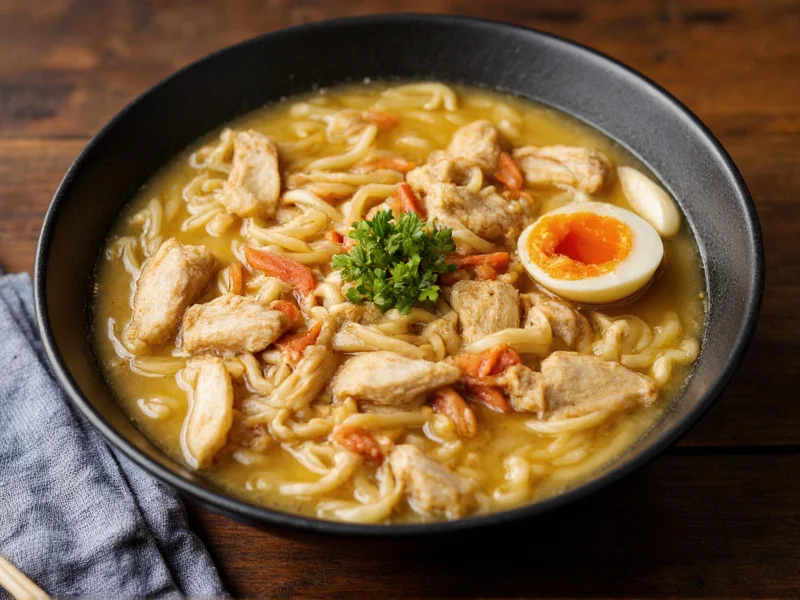When exploring how to make chicken noodle soup with udon, you're blending culinary traditions to create something uniquely satisfying. This Japanese-American fusion dish transforms the familiar Western comfort food by replacing traditional egg noodles with substantial udon, resulting in a more filling meal with delightful textural contrast. Unlike delicate ramen or soba, udon's thick wheat noodles maintain their satisfying chewiness even after prolonged simmering in broth, making them ideal for hearty soup preparations.
Understanding the Fusion: Traditional vs. Udon Adaptation
Classic chicken noodle soup typically features shredded chicken, vegetables like carrots and celery, and thin egg noodles in a clear broth. The udon variation maintains the soul-warming broth and protein but substitutes the noodles with thick, chewy Japanese udon. This simple swap creates a dramatically different eating experience—where traditional versions feel light and restorative, the udon version becomes a more substantial meal that can stand alone without additional sides.
Many home cooks wonder whether to use dried or fresh udon for chicken noodle soup. Fresh refrigerated udon offers superior texture but has a shorter shelf life, while dried packaged udon provides convenience with decent results when properly prepared. For authentic texture in your chicken udon noodle soup recipe, seek out Japanese markets for high-quality noodles, as supermarket "Asian aisle" options often lack the proper chew.
Essential Ingredients for Perfect Chicken Udon Soup
The magic of this dish lies in balancing Japanese and Western culinary elements. You'll need:
| Ingredient Category | Recommended Options | Why It Matters |
|---|---|---|
| Udon Noodles | Fresh refrigerated udon, dried premium udon | Provides the substantial chew that defines the dish; avoid cheap supermarket varieties that become mushy |
| Broth Base | Homemade chicken stock, quality store-bought broth with kombu addition | Foundation of flavor; Japanese dashi elements enhance traditional chicken broth |
| Chicken | Poached boneless thighs, shredded rotisserie chicken | Thighs stay moist during cooking; breasts often dry out in simmering broth |
| Aromatics | Garlic, ginger, scallions (in addition to traditional mirepoix) | Creates the flavor bridge between culinary traditions |
Step-by-Step Preparation Guide
Creating exceptional chicken noodle soup with udon requires attention to timing and technique. Follow these steps for optimal results:
- Prepare your broth foundation: Simmer chicken bones (if making from scratch) with onions, carrots, celery, and a 4-inch piece of kombu for 2-3 hours. For quicker preparation, enhance quality store-bought broth with kombu and bonito flakes.
- Cook udon separately: Boil udon according to package directions (usually 8-10 minutes for dried, 1-2 minutes for fresh), then immediately rinse under cold water to stop cooking and remove excess starch. This prevents mushiness when added to the soup.
- Build flavor layers: Sauté onions, carrots, celery, minced ginger and garlic until softened. Add to simmering broth along with shredded chicken and any desired vegetables like bok choy or mushrooms.
- Final assembly: Add cooked udon noodles just before serving to maintain optimal texture. Overcooking causes udon to become unpleasantly soft in the broth.
Popular Variations and Customizations
One reason chicken udon noodle soup has gained popularity is its adaptability. Consider these variations:
- Kyoto-style chicken udon: Features a clear, delicate broth made with chicken and kombu, served with just chicken, udon, and scallions
- Hearty American fusion: Incorporates traditional chicken soup vegetables like carrots and celery with the udon base
- Spicy ginger version: Adds fresh ginger slices and a dash of chili oil for warmth
- Weeknight quick version: Uses quality rotisserie chicken and pre-cooked udon for preparation under 30 minutes
For those exploring how to make chicken noodle soup with udon on a budget, frozen udon works surprisingly well and maintains decent texture when properly prepared. Simply thaw completely before adding to the broth.
Serving and Storage Recommendations
Serve chicken udon noodle soup immediately after assembly for best texture. Unlike traditional chicken soup where noodles can sit in broth, udon continues to absorb liquid and soften over time. For meal prep, store broth and noodles separately, combining only when ready to eat.
When storing leftovers, keep broth and noodles in separate containers. Properly stored, broth lasts 4-5 days refrigerated or up to 3 months frozen. Cooked udon maintains best texture for 2-3 days refrigerated. Reheat broth thoroughly before adding noodles to prevent sogginess.
Why This Fusion Works So Well
The success of chicken noodle soup udon lies in complementary textures and flavors. Udon's substantial chew provides satisfying mouthfeel that traditional egg noodles lack, while the familiar chicken broth creates immediate comfort. This dish exemplifies how thoughtful fusion cooking can enhance rather than dilute culinary traditions.
Professional chefs note that the key to exceptional chicken udon noodle soup is respecting both culinary traditions—using quality Japanese noodles while maintaining the soul-warming qualities of Western chicken soup. The result is a dish greater than the sum of its parts, offering both comfort and culinary interest.











 浙公网安备
33010002000092号
浙公网安备
33010002000092号 浙B2-20120091-4
浙B2-20120091-4